Londonderry
| Londonderry | |
| County Londonderry | |
|---|---|
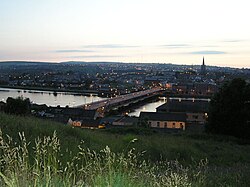 Londonderry at dusk | |
| Location | |
| Grid reference: | C434166 |
| Location: | 54°59’45"N, 7°18’27"W |
| Data | |
| Post town: | Londonderry |
| Postcode: | BT47, BT48 |
| Dialling code: | 028 |
| Local Government | |
| Council: | Derry and Strabane |
| Parliamentary constituency: |
Foyle |
Londonderry is the county town of County Londonderry, and the second-biggest city in Northern Ireland. The city stands at the mouth of the River Foyle as the rivermouth becomes Lough Foyle.
The old walled city lies on the west bank of the River Foyle, which is spanned by two bridges. The city now covers both banks (Cityside on the west and Waterside on the east). The population of the city proper (the area defined by its 17th century charter) was 83,652 in the 2001 Census, while the wider urban area had a population of 90,663.[1]
Londonderry is close to the border with County Donegal in the Republic of Ireland, with which it has had a close link for many centuries.
Geography
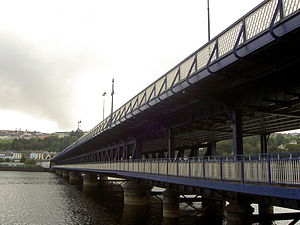
Londonderry is set in amongst a hilly landscape. The River Foyle forms a deep valley as it flows through the city, making Londonderry a place of very steep streets and sudden, startling views. The original walled city of Londonderry lies on a hill on the west bank of the River Foyle. In the past, the river branched and enclosed this wooded hill as an island; over the centuries, however, the western branch of the river dried up and became a low-lying and boggy district that is now called the Bogside.[2]
Today, modern Londonderry extends considerably north and west of the city walls and east of the river. The half of the city the west of the Foyle is known as the Cityside and the area east is called the Waterside. The Cityside and Waterside are connected by the Craigavon Bridge and Foyle Bridge.
Name
The city's earlier name, "Derry", is an Anglicisation of the Gaelic word Doire from the original Irish name Doire Cholmchille meaning "oak-wood of St Columba". In 1613, the city was granted a Royal Charter by King James I and in recognition of the contribution of the City of London livery companies in the city's re-foundation, the charter changed the name of the city to Londonderry.
The city is often known as simply Derry, though since the 1960s the choice of name has become a source of controversy, as Irish nationalists choose to object to the name Londonderry seeing it as a sign of British imperialism and unionists therefore avoid the abbreviation. In the Republic of Ireland, the city and county are almost always referred to as "Derry" on maps and in the media.[3] Official road signs in Northern Ireland use the name "Londonderry" (or abbreviated to "L'derry") while those in the Republic pointing to the city use only Derry (or Doire).
The city is also nicknamed the Maiden City by virtue of the fact that its walls were never breached during the Siege of Derry in the late 17th century.[4] It was also nicknamed Stroke City by local broadcaster, Gerry Anderson, due to the 'politically correct' use of the oblique notation Derry/Londonderry. A recent addition to the landscape has been the erection of several large stone columns on main roads into the city welcoming drivers, euphemistically, to "the walled city."
City walls
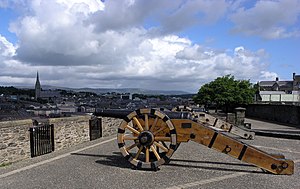
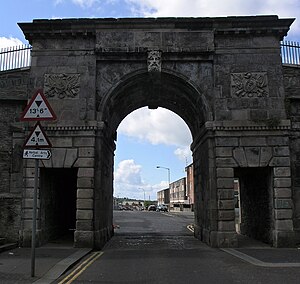
Londonderry is the only remaining completely intact walled city in the island of Ireland and one of the finest examples of a walled city in Europe.[5][6] The walls constitute the largest monument in State care in Northern Ireland and, as the last walled city to be built in Europe, stands as the most complete and spectacular.[7]
The Walls were built during the period 1613-1619 by The Honourable The Irish Society as defences for early 17th century settlers from Great Britain. The Walls are approximately 1 mile in circumference and vary in height and width between 12 and 35 feet. They are completely intact and form a walkway around the inner city. The walls provide a unique promenade to view the layout of the original town which still preserves its Renaissance style street plan. The four original gates to the Walled City are Bishop’s Gate, Ferryquay Gate, Butcher Gate and Shipquay Gate to which three further gates were added later, Magazine Gate, Castle Gate and New Gate, making seven gates in total. Historic buildings within the walls include the 1633 Gothic cathedral of St Columb, the Apprentice Boys Memorial Hall and the courthouse.
Londonderry is one of the few cities in Europe that never saw its fortifications breached, withstanding several sieges including one in 1689 which lasted 105 days, hence the city's nickname, The Maiden City.[8]
History

The city has long been a focal point for important events in Irish history, including the 1688-1689 Siege of Derry.
Early history
The person traditionally seen as the founder of the original Derry is Saint Columba, or Colmcille, a missionary monk from Tír Chonaill, the old name for almost all of modern County Donegal and the west bank of the Foyle. The earliest historical references date to the 6th century when Columba founded a monastery at Doire Calgaich, which became Doire Cholmchille. According to oral and documented history, the site was granted to Columba by a local Ulster king.[9] The monastery then remained in the hands of the federation of Columban churches who regarded Columba as their spiritual mentor. While the traditional foundation year of 546 is accepted to be erroneous, it is accepted that Derry was known primarily as a monastic settlement between the 6th and 11th centuries.
The town became strategically more significant during the Tudor conquest of Ireland and came under frequent attack, until in 1608 it was destroyed by Cahir O'Doherty, Irish chieftain of Inishowen.[10]
Plantation
Planters organised by London livery companies through The Honourable The Irish Society arrived in the 17th century as part of the plantation of Ulster, and built the city of Londonderry across the Foyle from the earlier town, with walls to defend it from Irish insurgents who did not welcome the occupation. The aim was to settle Ulster with a population supportive of the Crown.
Londonderry was the first planned city in Ireland: it was begun in 1613, with the walls being completed 5 years later in 1618, at a cost of £10,757.[11] The central diamond within a walled city with four gates was thought to be a good design for defence. The grid pattern chosen was subsequently much copied in the colonies of British North America.[12] The charter initially defined the city as extending three Irish miles from the centre.
The modern city preserves the 17th century layout of four main streets radiating from a central Diamond to four gateways — Bishop's Gate, Ferryquay Gate, Shipquay Gate and Butcher's Gate. The city's oldest surviving building was also constructed at this time: the 1633 Plantation Gothic Cathedral of St Columb. In the porch of the cathedral is a stone that records completion with the inscription:
If stones could speake, then London's prayse should sound, Who built this church and cittie from the grounde.[13]
17th-century upheavals
During the 1640s, the city suffered in the Wars of the Three Kingdoms, which began with the Irish Rebellion of 1641, when the Gaelic Irish insurgents made a failed attack on the city. In 1649 the city and its garrison, which supported the English Parliament against the King, were besieged by Scottish Presbyterian forces loyal to King Charles I. The Parliamentarians besieged in Londonderry were relieved by a strange alliance of Roundhead troops under George Monck and the Irish Catholic general Owen Roe O'Neill. These temporary allies were soon fighting each other again however, after the landing in Ireland of the New Model Army in 1649. The war in Ulster was finally brought to an end when the Parliamentarians crushed the Irish Catholic Ulster army at the battle of Scarrifholis in nearby Donegal in 1650.
During the Glorious Revolution of 1688, only Londonderry and nearby Enniskillen had a Protestant garrison by November 1688. An army of around 1,200 men, mostly "Redshanks" (Highlanders), under Alexander Macdonnell, 3rd Earl of Antrim, was slowly organised (they set out on the week William of Orange landed in England). When they arrived on 7 December 1688 the gates were closed against them and the Siege of Derry began. In April 1689, King James came to the city and summoned it to surrender. The King was rebuffed and the siege lasted until the end of July with the arrival of a relief ship.
18th and 19th centuries
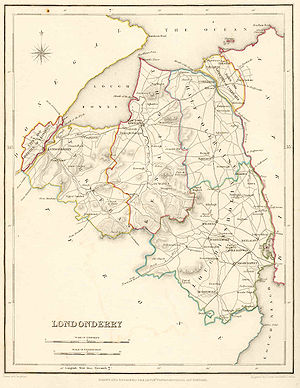
The city was rebuilt in the 18th century with many of its fine Georgian style houses still surviving. The city's first bridge across the River Foyle was built in 1790. During the 18th and 19th centuries the port became an important embarkation point for Irish emigrants setting out for North America. Some of these founded the colonies of Derry and Londonderry in the state of New Hampshire.
Also during the 19th century, it became a destination for migrants fleeing areas more severely affected by the Irish Potato Famine.[14] One of the most notable shipping lines was the McCorkell Line operated by Wm. McCorkell & Co. Ltd. from 1778.[15] The McCorkell's most famous ship was the Minnehaha, which was known as the "Green Yacht from Derry".[15]
After Irish independence
During the Irish War of Independence, the area was rocked by sectarian violence, partly prompted by the guerrilla war raging between the Irish Republican Army and British forces, but also influenced by economic and social pressures. By mid 1920 there was severe sectarian rioting in the city. Many lives were lost and in addition many Catholics and Protestants were expelled from their homes during this communal unrest. After a week's violence, a truce was negotiated by local politicians on both unionist and republican sides.
In 1921, following the Anglo-Irish Treaty and the partition of Ireland, it unexpectedly became a border city, separated from much of its traditional economic hinterland in County Donegal.
During the Second World War, the city played an important part in the Battle of the Atlantic. Ships from the Royal Navy, the Royal Canadian Navy, and other Allied navies were stationed in the city and the United States military established a base. The reason for such a high degree of military and naval activity was self-evident: Londonderry was the United Kingdom's westernmost port; indeed, the city was the westernmost Allied port in Europe: thus, Londonderry was a crucial jumping-off point, together with Glasgow and Liverpool, for the shipping convoys that ran between Europe and North America. The large numbers of military personnel in Londonderry substantially altered the character of the city, bringing in some outside colour to the local area, as well as some cosmopolitan and economic buoyancy during these years. At the conclusion of the Second World War, eventually some 60 U-boats of the German Kriegsmarine ended in the city's harbour at Lisahally after their surrender.[16]
Landmarks

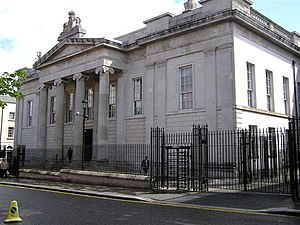
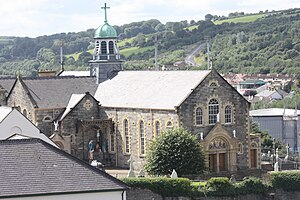
Londonderry is renowned for its architectural quality. This can be primarily ascribed to the formal planning of the historic walled city of Londonderry at the core of the modern city. This is centred on the Diamond with a collection of late Georgian, Victorian and Edwardian buildings maintaining the gridlines of the main thoroughfares (Shipquay Street, Ferryquay Street, Butcher Street and Bishop Street) to the City Gates. St Columb's Cathedral does not follow the grid pattern reinforcing its civic status. This Church of Ireland Cathedral was the first Cathedral built after the Reformation in the British Isles.
A Roman Catholic cathedral, St Eugene's Cathedral, was built in the Bogside in the 19th-century. The more recent infill buildings within the walls are of varying quality and in many cases these were low quality hurriedly constructed replacements for 1970s bomb damaged buildings. The Townscape Heritage Initiative has funded restoration works to key listed buildings and other older structures.
In the three centuries since their construction, the city walls have been adapted to meet the needs of a changing city. The best example of this adaptation is the insertion of three additional gates — Castle Gate, New Gate and Magazine Gate — into the walls in the course of the 19th century. Today, the fortifications form a continuous promenade around the city centre, complete with cannon, avenues of mature trees and views across Londonderry. Historic buildings within the city walls include St Augustine's Church, which sits on the city walls close to the site of the original monastic settlement; the copper-domed Austin's department store, which claims to the oldest such store in the world; and the imposing Greek Revival Courthouse on Bishop Street. The red-brick late-Victorian Guildhall, also crowned by a copper dome, stands just beyond Shipquay Gate and close to the river front.
There are many museums and sites of interest in and around the city, including the Foyle Valley Railway Centre, the Amelia Earhart Centre and Wildlife Sanctuary, the Apprentice Boys Memorial Hall, Ballyoan Cemetery, The Bogside, numerous sectarian murals, the Guildhall, the Harbour Museum, Chapter House Museum, the Workhouse Museum, the Nerve Centre, St Columb's Park and Leisure Centre, St Eugene's Cathedral, Creggan Country Park, The Millennium Forum and the Foyle and Craigavon bridges.
Future projects include the Walled City Signature Project, which intends to ensure that the city's walls become a world class tourist experience.[17]
The city has seen a large boost to its economy in the form of tourism over the last few years. Cheap flights offered by budget airlines have enticed many people to visit the city. Tourism mainly focuses around the pubs, mainly those of Waterloo Street. Other attractions include museums, the sites of the town and trips to the Giant's Causeway, 50 miles away.

Events
- The Big Tickle Comedy Festival (March)
- City Of Derry Jazz And Big Band Festival in April
- The Foyle Film Festival (November); the biggest film festival in Northern Ireland.
- Tomo-Dachi, Ireland's largest Anime convention
- The "Banks of the Foyle Hallowe’en Carnival" [1] (October)
- The Maiden City Festival – a weeklong festival in which the Apprentice Boys of Derry celebrate The Siege of Derry
- The Instinct Festival (Easter) - an annual youth festival celebrating the Arts
- The Millennium Forum is the main theatre in the city, it holds numerous shows weekly
Outside links
References
- ↑ "Statistical Classification and Delineation of Settlements - February 2005" (PDF). http://www.nisra.gov.uk/archive/demography/publications/urban_rural/ur_gaz.pdf. Retrieved 2010-06-20.
- ↑ "HISTORY – THE BOGSIDE". Museum of Free Derry. http://www.museumoffreederry.org/history-bogside01.html. Retrieved 2010-02-13.
- ↑ "Irish Rail network showing 'Derry'". Iarnród Éireann. http://www.irishrail.ie/images/maps/intercity_map.gif. Retrieved 2009-07-29.
- ↑ "The Walled City Experience". Northern Ireland Tourist Board. http://www.discovernorthernireland.com/article.aspx?ArticleID=1588. Retrieved 2008-09-04.
- ↑ "Antrim and Derry". Roughguides.com. http://www.roughguides.com/website/Travel/Destination/content/default.aspx?titleid=160&xid=idh168000912_0583. Retrieved 2010-06-20.
- ↑ "County Derry, Northern Ireland - Londonderry". Irelandwide.com. http://www.irelandwide.com/regional/ulster/county_derry/index.htm. Retrieved 2010-06-20.
- ↑ "City Walls Conservation Plan. pdf doc. p19". http://www.ni-environment.gov.uk/derry-lowres.pdf.
- ↑ Historic Walls of Derry Discover Northern Ireland website
- ↑ "History of Derry". www.geographia.com. http://www.geographia.com/norThern-ireland/ukider01.htm. Retrieved 2010-02-13.
- ↑ "King ponders plantation". www.irishtimes.com/. http://www.irishtimes.com/focus/earls/theflight/flight3.html. Retrieved 2010-02-13.
- ↑ "Walls Constructed". www.derryswalls.com. http://www.derryswalls.com/hist-walls-constructed.html. Retrieved 2010-02-13.
- ↑ "World Facts Index > United Kingdom > Londonderry". worldfacts.us. 2005. http://worldfacts.us/UK-Londonderry.htm. Retrieved 2006-09-05.
- ↑ "Brief History of St Columb's Cathedral Londonderry". www.stcolumbscathedral.org. http://www.stcolumbscathedral.org/History.htm. Retrieved 2010-02-13.
- ↑ Johnson, James H. (1957). "The population of Londonderry during the Great Irish Famine". The Economic History Review (Blackwell Publishing) 10 (2): 273–285. doi:10.2307/2590863. http://www.jstor.org/stable/2590863.
- ↑ 15.0 15.1 http://www.mccorkellline.com/ McCorkell Line
- ↑ "The U-boat surrender". www.secondworldwarni.org. http://www.secondworldwarni.org/print.aspx?pagerecordid=1469. Retrieved 2010-02-13.
- ↑ "Walled City of Derry – Signature Project". Archived from the original on 2008-02-02. http://web.archive.org/web/20080202030606/http://www.nitb.com/article.aspx?ArticleID=809. The Industry Website of the Northern Ireland Tourist Board. Retrieved 10 September 2006.